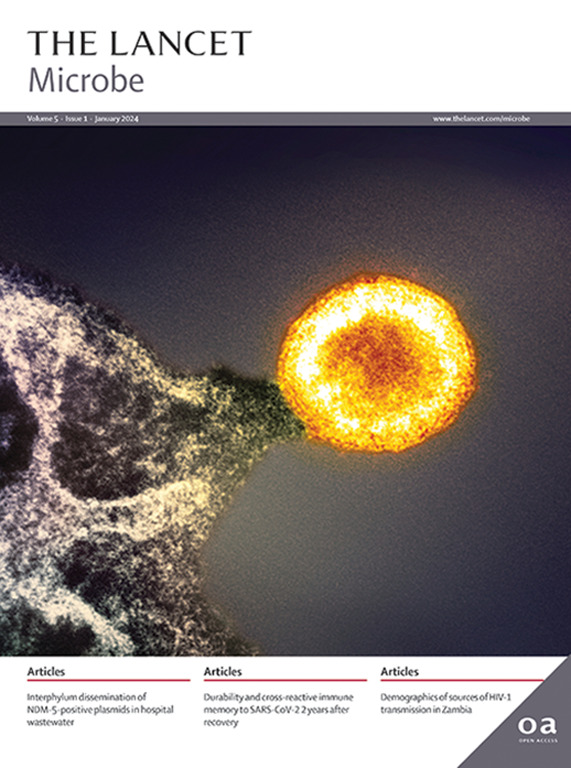Universal versus targeted chlorhexidine and mupirocin decolonisation and clinical and molecular epidemiology of Staphylococcus epidermidis bloodstream infections in patients in intensive care in Scotland, UK: a controlled time-series and longitudinal genotypic study
IF 20.4
1区 生物学
Q1 INFECTIOUS DISEASES
引用次数: 0
Abstract
Background
There are concerns that biocide skin and mucous membrane decolonisation, which is widely used to prevent health-care-associated infections in intensive care units (ICUs), might select for multidrug-resistant pathogens. We aimed to evaluate the effects of de-escalating from universal to targeted skin and nasal decolonisation on Staphylococcus epidermidis bloodstream infections (SE-BSI).
Methods
We did a retrospective, before-after-control-impact time-series analysis and longitudinal genotypic study in two ICUs with divergent decolonisation practice in tertiary care hospitals of adjacent health boards in Scotland, UK. Participants were aged at least 16 years and admitted between July 1, 2009, and Feb 28, 2022. There were no exclusion criteria for the study. In ICU one (intervention site) universal decolonisation in all admissions was de-escalated to targeted decolonisation of meticillin-resistant Staphylococcus aureus (MRSA) carriers on Feb 1, 2019, while in ICU two (control site) targeted decolonisation was applied throughout. We collected bloodstream infection data from all causes, including clinically significant SE-BSI. Antimicrobial susceptibility testing was used to define meticillin-resistant S epidermidis (MRSE) and chlorhexidine susceptibility. We used multilocus sequence typing to identify sequence types from archived SE-BSI isolates. Whole-genome sequencing was applied to a sample from ICU one. The primary outcomes were incidence densities of all bloodstream infections, SE-BSI, and meticillin-resistant S epidermidis bloodstream infections (MRSE-BSI), and the percentage probability that SE-BSI were MRSE-BSI. The effects of de-escalation on primary outcomes were estimated by differences between the intervention and control sites, before and after de-escalation, using a before-after-control-impact time-series design. Secondary outcomes included the proportion of multidrug resistant sequence types, carriage of mobile genetic elements and genes for multidrug resistance and biofilm production.
Findings
Between July 1, 2009, and Feb 28, 2022, S epidermidis was identified in 334 (45%) of 735 bloodstream infections in ICU one, of which 197 occurred before the de-escalation intervention in Feb 1, 2019, and S epidermidis was identified in 167 (60%) of 278 bloodstream infections in ICU two. There was no increase in all bloodstream infection incidence coinciding with de-escalation in ICU one, whereas MRSE-BSI incidence declined significantly from 10·4 cases per 1000 occupied bed days (OBDs; 95% credible interval [CrI] 7·2–15·4) to 4·3 cases per 1000 OBDs (2·5–6·7), as did the percentage probability of MRSE (from 89·2%, 95% CrI 77·8–96·5 to 56·7%, 34·3–77·5%). No significant changes in the primary outcomes were seen in ICU two. MRSE-BSI incidence density was positively associated with chlorhexidine use, but not mupirocin use. De-escalation was associated with a reduced proportion of SE-BSI due to multidrug-resistant sequence types and reduced carriage of mobile genetic elements and genes for multidrug resistance and biofilm production, as observed by multi-locus sequence typing and whole genome sequencing.
Interpretation
In ICU settings with low MRSA incidence, the benefits of universal decolonisation should be balanced against the risks of selecting MRSE sequence types adapted for invasive and device-associated infection.
Funding
National Health Service Grampian Charity.
英国苏格兰重症监护患者表皮葡萄球菌血液感染的普遍与靶向氯己定和莫匹罗星去定植以及临床和分子流行病学:一项对照时间序列和纵向基因型研究。
背景:人们担心,在重症监护病房(icu)广泛用于预防卫生保健相关感染的杀菌剂皮肤和粘膜去殖民化可能会选择耐多药病原体。我们的目的是评估从普遍到靶向皮肤和鼻腔去殖民化对表皮葡萄球菌血流感染(SE-BSI)的影响。方法:我们对英国苏格兰邻近卫生局三级医院的两个非殖民化实践不同的icu进行了回顾性、前后对照影响时间序列分析和纵向基因型研究。参与者年龄至少16岁,在2009年7月1日至2022年2月28日期间入院。本研究没有排除标准。在1号ICU(干预点),所有入院患者的普遍去菌落在2019年2月1日逐步升级为耐甲氧西林金黄色葡萄球菌(MRSA)携带者的靶向去菌落,而在2号ICU(对照点),靶向去菌落一直应用。我们收集了所有原因的血流感染数据,包括临床显著的SE-BSI。采用药敏试验确定耐甲氧西林金黄色葡萄球菌(MRSE)和氯己定的药敏。我们使用多位点序列分型从存档的SE-BSI分离株中鉴定序列类型。全基因组测序应用于ICU 1的样本。主要结局是所有血流感染、SE-BSI和耐甲氧西林表皮S型血源性感染(MRSE-BSI)的发生率密度,以及SE-BSI为MRSE-BSI的百分比概率。降级对主要结局的影响通过干预点和对照点之间的差异来估计,在降级之前和之后,使用控制影响之前-之后的时间序列设计。次要结局包括多药耐药序列类型的比例、可移动遗传元件的携带以及多药耐药和生物膜产生的基因。结果:2009年7月1日至2022年2月28日期间,第一重症监护室735例血流感染中有334例(45%)发现表皮S型感染,其中197例发生在2019年2月1日降级干预之前,第二重症监护室278例血流感染中有167例(60%)发现表皮S型感染。在ICU中,所有血液感染发生率均未增加,而MRSE-BSI发生率从每1000个床位日10.4例(obd)显著下降;95%可信区间[CrI] 7.2 - 15.4)至4.3例/ 1000 obd(2.5 -6·7),MRSE的百分比概率(从89.2%,95% CrI为77.8 - 96.5至56.7%,34.3 - 77.5%)也是如此。第二重症监护室的主要结局未见明显变化。MRSE-BSI发生率密度与氯己定的使用呈正相关,而与莫匹罗星的使用无关。通过多位点序列分型和全基因组测序发现,由于多药耐药序列类型以及可移动遗传元件和多药耐药和生物膜产生基因的携带减少,降级与SE-BSI比例降低相关。解释:在低MRSA发病率的ICU环境中,普遍去菌落的好处应该与选择适合侵袭性和器械相关感染的MRSE序列类型的风险相平衡。资助:格兰平原国家卫生服务慈善机构。
本文章由计算机程序翻译,如有差异,请以英文原文为准。
求助全文
约1分钟内获得全文
求助全文
来源期刊

Lancet Microbe
Multiple-
CiteScore
27.20
自引率
0.80%
发文量
278
审稿时长
6 weeks
期刊介绍:
The Lancet Microbe is a gold open access journal committed to publishing content relevant to clinical microbiologists worldwide, with a focus on studies that advance clinical understanding, challenge the status quo, and advocate change in health policy.
 求助内容:
求助内容: 应助结果提醒方式:
应助结果提醒方式:


